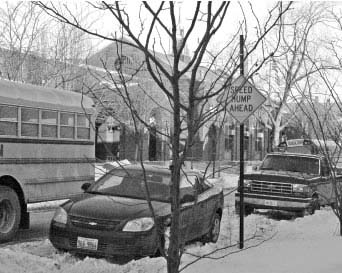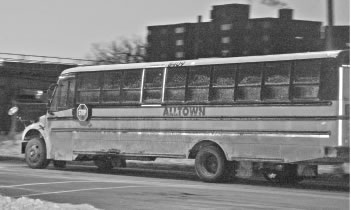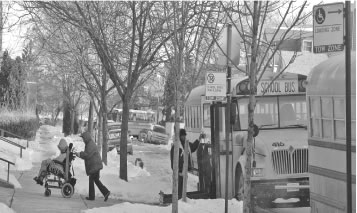Alltown Bus Company Adds to Cold Danger by not pre-Heating Buses
After a mild January 2007, Chicago and the city’s schools faced challenges during February that the city hadn’t seen in a decade. Record low temperatures combined with snow to produce conditions that could lead to frostbite within ten minutes, according to the news warnings from the National Weather Service and local hospitals.
What the city didn’t expect — and barely noticed — was that the conditions of extreme cold often affected children and staff inside the school buses they rode to school every day. The refusal of at least one CPS bus contractor to allow its buses to be pre-heated (plus the possibility that many of the buses serving Chicago schools are built for warmer climates) left both staff (drivers, bus aides, child welfare attendants) and children shivering inside the buses that could have been warmed up before departing, just as parents were pre-heating their cars before taking their children to school.
By Valentine’s Day (February 14) the combination of snow and cold had forced the Chicago Public Schools to issue a notice that said: “The Chicago Public Schools will be open on Wednesday, February 14, but there will be no bus service. Students who normally ride the bus may attend their neighborhood school.”
 February 16, 2007, Christopher School. By February 16, Chicago had endured two weeks of mostly sub-zero overnight temperatures and most of the challenges of the worst Chicago winters. These included drifting snow, such as that across the street from the Christopher special education school (the peaked building, above left, at 5042 S. Artesian). While media reports warned parents that children could suffer frostbite from as little as ten minutes’ exposure to the bitter cold, the bus workers (drivers and aides) who serve the children with disabilities who attend Christopher shared an additional danger with the children: frosty temperatures inside the buses! (Substance photo by George N. Schmidt)The reason for the implementation of the procedure outlined in the school system’s emergency plans was that the snow had made many side streets difficult to navigate. The confusion to parents and children was exacerbated by the fact that walking to schools or even standing on street corners was, as numerous TV reports made clear, dangerous because of the cold.
February 16, 2007, Christopher School. By February 16, Chicago had endured two weeks of mostly sub-zero overnight temperatures and most of the challenges of the worst Chicago winters. These included drifting snow, such as that across the street from the Christopher special education school (the peaked building, above left, at 5042 S. Artesian). While media reports warned parents that children could suffer frostbite from as little as ten minutes’ exposure to the bitter cold, the bus workers (drivers and aides) who serve the children with disabilities who attend Christopher shared an additional danger with the children: frosty temperatures inside the buses! (Substance photo by George N. Schmidt)The reason for the implementation of the procedure outlined in the school system’s emergency plans was that the snow had made many side streets difficult to navigate. The confusion to parents and children was exacerbated by the fact that walking to schools or even standing on street corners was, as numerous TV reports made clear, dangerous because of the cold.
The bitter cold began to hit Chicago on (Monday) February 5 and continued, in varying intensities, through (Saturday) February 17
An additional problem had begun with the onset of the cold and continued with the resumption of bus service on February 15. The cold’s continuation throughout the cold wave that saw Chicago temperatures drop to below zero and wind chills (now called “feels like”) to 30 below had an additional impact on those who drove, worked on, or rode the buses furnished to CPS by the Alltown Bus Company.
 February 16, 2007, Alltown Bus Company, 63rd and Prairie in Chicago. Although officials from CPS had checked inside temperatures on the Alltown buses (finally) on February 15, buses like the one above were still leaving the lot at 6:00 a.m. with frost on inside of windows. (Substance photo by George N. Schmidt)During the cold wave, Substance confirmed that Alltown procedures barred drivers from pre-heating the buses prior to their going out on their routes during the cold weather. As a result, dozens of employees and hundreds of children were forced to ride to school while temperatures inside the buses were at or below freezing.
February 16, 2007, Alltown Bus Company, 63rd and Prairie in Chicago. Although officials from CPS had checked inside temperatures on the Alltown buses (finally) on February 15, buses like the one above were still leaving the lot at 6:00 a.m. with frost on inside of windows. (Substance photo by George N. Schmidt)During the cold wave, Substance confirmed that Alltown procedures barred drivers from pre-heating the buses prior to their going out on their routes during the cold weather. As a result, dozens of employees and hundreds of children were forced to ride to school while temperatures inside the buses were at or below freezing.
The problem began the week before CPS cancelled one-day of bus service, and lasted until the bitter cold ended. At the beginning of the week of Valentine’s Day (February 12 - 16), complaints that had begun the previous week continued about the refusal to preheat the buses.
According to reliable source (who asked not to be identified because of the risk to their jobs), Alltown was confiscating keys from drivers and only issuing them at the last minute when they were told to begin their routes. As the temperatures dropped, the procedure insured that the buses wouldn’t be running long enough to heat up inside before the workers began their day and the children were picked up to go to school.
Alltown is located at 6300 S. Prairie, and on February 16, this reporter spent the first half hour of the work day watching the buses pull out of the Alltown lot with frost on the inside of the windows. I then followed one of the buses on its route from 63rd and Prairie to the Christopher Elementary School, a Chicago public school that serves special education children with severe handicaps. Christopher is located at 51st and Artesian.
I spent four hours Friday morning (February 16, 2007) finishing that story about the special education buses run by Alltown. During those hours, the “feels like” temperature outside in Chicago was around minus ten, with the predicted low for the day minus 15.
By Friday at 6:00 a.m., the buses at Alltown were warming up for a few minutes before they pulled out (something that hadn’t been done earlier in the cold wave, according to reliable sources). An observer standing on the northwest corner of 63rd and Prairie could watch that taking place.  February 16, 2007, Christopher school, 5042 S. Artesian, Chicago. Bus aides and child welfare attendants wheel children into the special education school the day after CPS finally recognized the problem with the Alltown buses. (Substance photo by George N. Schmidt)So theoretically they were warm(er) before the pulled out than they had been during the more than ten days since the below zero weather began in Chicago. Nevertheless, it was possible to observe buses beginning their routes with frost on the inside of windows. Observers could follow buses through their pickup routes. Many of the children served by the Alltown routes are in wheelchairs. With snow and bitter cold, the drivers and bus aides (and parents and children) have serious challenges. If, for example, the snowplows came through during the night, there are ridges to maneuver over that weren’t there the night before. The first pick-ups are a little after six a.m. An observer could then watch a block long line of buses unload at Christopher around 7:30 a.m.
February 16, 2007, Christopher school, 5042 S. Artesian, Chicago. Bus aides and child welfare attendants wheel children into the special education school the day after CPS finally recognized the problem with the Alltown buses. (Substance photo by George N. Schmidt)So theoretically they were warm(er) before the pulled out than they had been during the more than ten days since the below zero weather began in Chicago. Nevertheless, it was possible to observe buses beginning their routes with frost on the inside of windows. Observers could follow buses through their pickup routes. Many of the children served by the Alltown routes are in wheelchairs. With snow and bitter cold, the drivers and bus aides (and parents and children) have serious challenges. If, for example, the snowplows came through during the night, there are ridges to maneuver over that weren’t there the night before. The first pick-ups are a little after six a.m. An observer could then watch a block long line of buses unload at Christopher around 7:30 a.m.
According to reliable sources, CPS had people out Thursday (February 15) checking the temperatures inside the buses — at Christopher (51st and Artesian), but not, according to my sources, at Alltown (63rd and Prairie). CPS has also been working on ways of dealing with these problems, they say. Late on Friday, February 16, Mike Vaughn (CPS Communications Dept.) stated that according to people in the Board’s transportation department, the reason for the problems on the special education buses was that the wheelchair lift doors have to be kept open for long periods of time. This made it impossible to maintain interior heat for the workers and children inside them. By the last week of February, the “feels like” temperatures well below zero were a memory.


